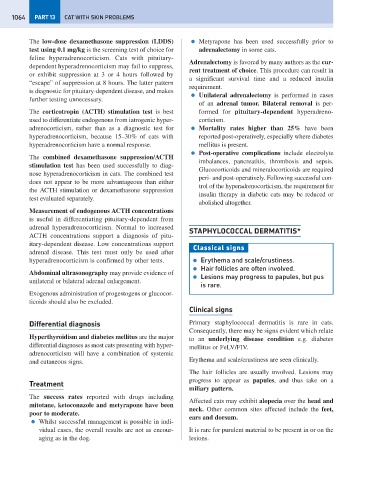Page 1072 - Problem-Based Feline Medicine
P. 1072
1064 PART 13 CAT WITH SKIN PROBLEMS
The low-dose dexamethasone suppression (LDDS) ● Metyrapone has been used successfully prior to
test using 0.1 mg/kg is the screening test of choice for adrenalectomy in some cats.
feline hyperadrenocorticism. Cats with pituitary-
Adrenalectomy is favored by many authors as the cur-
dependent hyperadrenocorticism may fail to suppress,
rent treatment of choice. This procedure can result in
or exhibit suppression at 3 or 4 hours followed by
a significant survival time and a reduced insulin
“escape” of suppression at 8 hours. The latter pattern
requirement.
is diagnostic for pituitary-dependent disease, and makes
● Unilateral adrenalectomy is performed in cases
further testing unnecessary.
of an adrenal tumor. Bilateral removal is per-
The corticotropin (ACTH) stimulation test is best formed for pituitary-dependent hyperadreno-
used to differentiate endogenous from iatrogenic hyper- corticism.
adrenocorticism, rather than as a diagnostic test for ● Mortality rates higher than 25% have been
hyperadrenocorticism, because 15–30% of cats with reported post-operatively, especially where diabetes
hyperadrenocorticism have a normal response. mellitus is present.
● Post-operative complications include electrolyte
The combined dexamethasone suppression/ACTH
imbalances, pancreatitis, thrombosis and sepsis.
stimulation test has been used successfully to diag-
Glucocorticoids and mineralocorticoids are required
nose hyperadrenocorticism in cats. The combined test
peri- and post-operatively. Following successful con-
does not appear to be more advantageous than either
trol of the hyperadrenocorticism, the requirement for
the ACTH stimulation or dexamethasone suppression
insulin therapy in diabetic cats may be reduced or
test evaluated separately.
abolished altogether.
Measurement of endogenous ACTH concentrations
is useful in differentiating pituitary-dependent from
adrenal hyperadrenocorticism. Normal to increased
STAPHYLOCOCCAL DERMATITIS*
ACTH concentrations support a diagnosis of pitu-
itary-dependent disease. Low concentrations support
Classical signs
adrenal disease. This test must only be used after
hyperadrenocorticism is confirmed by other tests. ● Erythema and scale/crustiness.
● Hair follicles are often involved.
Abdominal ultrasonography may provide evidence of
● Lesions may progress to papules, but pus
unilateral or bilateral adrenal enlargement.
is rare.
Exogenous administration of progestogens or glucocor-
ticoids should also be excluded.
Clinical signs
Differential diagnosis Primary staphylococcal dermatitis is rare in cats.
Consequently, there may be signs evident which relate
Hyperthyroidism and diabetes mellitus are the major to an underlying disease condition e.g. diabetes
differential diagnoses as most cats presenting with hyper- mellitus or FeLV/FIV.
adrenocorticism will have a combination of systemic
and cutaneous signs. Erythema and scale/crustiness are seen clinically.
The hair follicles are usually involved. Lesions may
progress to appear as papules, and thus take on a
Treatment
miliary pattern.
The success rates reported with drugs including
Affected cats may exhibit alopecia over the head and
mitotane, ketoconazole and metyrapone have been
neck. Other common sites affected include the feet,
poor to moderate.
ears and dorsum.
● Whilst successful management is possible in indi-
vidual cases, the overall results are not as encour- It is rare for purulent material to be present in or on the
aging as in the dog. lesions.

